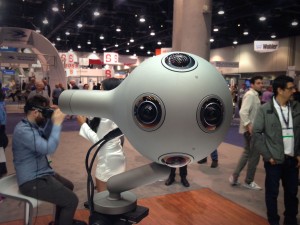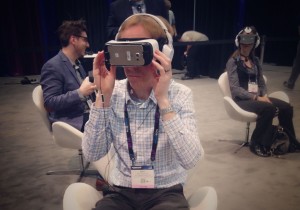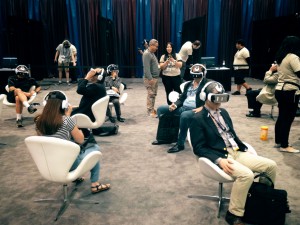Trend Watching from The 2016 National Association of Broadcasters Convention
 If you’ve read my previous post about 360-degree videos in higher education, you might remember the tour from the Werth Family UConn Basketball Champions Center.
If you’ve read my previous post about 360-degree videos in higher education, you might remember the tour from the Werth Family UConn Basketball Champions Center.
This video was produced by Bret Eckhardt, Multimedia Manager at the University of Connecticut, I interviewed a few months ago for my UB column.
Bret recently attended the 2016 NAB Show in Las Vegas and was kind enough to play the role of CollegeWebEditor special correspondent to be your eyes and ears in Las Vegas. He came back with the guest post below about the top 5 virtual reality trends to watch for higher ed marketers.

Virtual Reality dominated discussion at the recent convention of the National Association of Broadcasters (NAB) in Las Vegas. VR headsets, cameras and microphones were on full display at the world’s largest annual conference for professionals who create, manage, and distribute video across all platforms.
The consensus among the throngs of participants was that this emerging medium will have a major impact on way the people consume media. The ability of VR to transport people to the scene of everything from sporting events to war zones was demonstrated by examples shared by major media outlets.
This represents an exciting opportunity for Higher Ed storytelling and marketing, too, especially as the price of the technology decreases.
We are still a few years away from mass adoption of VR, but here are 5 of the top trends.
1) 360-Degree Live-streaming
 YouTube officially announced it will support 360-degree live-streaming. This will allow users to experience a live event in full 360-degree video on their computers, mobile devices or through headsets like Google Cardboard.
YouTube officially announced it will support 360-degree live-streaming. This will allow users to experience a live event in full 360-degree video on their computers, mobile devices or through headsets like Google Cardboard.
The potential applications of this technology in Higher Ed are great. University audiences will have the opportunity to “virtually†attend live lectures, concerts, and sporting events. Students in the classroom will experience news events as they unfold. Even family members can immerse themselves in a graduation ceremony if they’re unable to attend.
2) Spatial Audio
 YouTube also launched a capability called “spatial audio†within VR videos. Spatial audio is spherical sound that can be experienced in 360 degrees. For instance, in a virtual reality experience, if you hear a sound that comes from above you, you can look up and see what is causing the noise.
YouTube also launched a capability called “spatial audio†within VR videos. Spatial audio is spherical sound that can be experienced in 360 degrees. For instance, in a virtual reality experience, if you hear a sound that comes from above you, you can look up and see what is causing the noise.
This capability is significant for VR creators because spatial audio will allow them to direct the viewers’ attention. One of the challenges of storytelling in VR is that viewers can choose which direction to look at any given time. Therefore, the ability to lead a viewers’ gaze using spatial audio is a powerful tool.
3) Proximity
 One of the most important aspects of the VR experience is achieving what many in the industry call “presence.†This is the belief by a user that they are actually “there.†Different aspects of a production can determine how effective the illusion is, but many creators are in agreement that the proximity of the camera to the action is vital to achieving a sense of presence.
One of the most important aspects of the VR experience is achieving what many in the industry call “presence.†This is the belief by a user that they are actually “there.†Different aspects of a production can determine how effective the illusion is, but many creators are in agreement that the proximity of the camera to the action is vital to achieving a sense of presence.
For Higher Ed video producers, this will mean positioning the camera very close to faculty members giving a lecture, or the President delivering an address. If the camera is too far away, it can lead to a less immersive experience.
4) Empathy Machines
 The immersive nature of virtual reality means it has an enormous potential to evoke empathy in the user. VR content creators for USA Today, Huffington Post and The Associated Press referred to cameras and headsets as “empathy machines.†For instance, a 360-degree camera placed in a war zone will allow viewers to experience a soldier or civilian’s reality with a level of authenticity never seen before.
The immersive nature of virtual reality means it has an enormous potential to evoke empathy in the user. VR content creators for USA Today, Huffington Post and The Associated Press referred to cameras and headsets as “empathy machines.†For instance, a 360-degree camera placed in a war zone will allow viewers to experience a soldier or civilian’s reality with a level of authenticity never seen before.
This potential for deep emotional experience can lead to positive action.
For Higher Ed marketers, the nature of this new medium represents a great opportunity for connecting audiences such as prospective students and their parents to the university.
5) Mass Adoption of VR is coming
 The language of virtual reality is still very much in development. Many of the storytelling techniques used in traditional video production, such as panning and tilting, don’t necessarily apply in 360-degree space.
The language of virtual reality is still very much in development. Many of the storytelling techniques used in traditional video production, such as panning and tilting, don’t necessarily apply in 360-degree space.
Even the language used to describe VR is unclear; do you watch it? Experience it? Do it? One thing seems to be certain, however: mass adoption of VR is coming.
According to experts at NAB, we’re still two to three years out from widespread use of the technology, but with many phone and camera companies investing heavily in the space, Higher Ed marketing departments should begin exploring the attributes of this new medium.




New post: College Web Editor – Top 5 Virtual Reality Trends to Watch for #HigherEd https://t.co/B8facBP1wc
RT @karinejoly: GREAT READ by @breteckhardt – Top 5 Virtual Reality Trends to Watch for #HigherEd https://t.co/kkPZlQifG1 #hesm https://t.c…
College Web Editor – Top 5 Virtual Reality Trends to Watch for #HigherEd https://t.co/wbPlXnJqp8
RT @karinejoly: GREAT READ by @breteckhardt – Top 5 Virtual Reality Trends to Watch for #HigherEd https://t.co/kkPZlQifG1 #hesm https://t.c…
RT @karinejoly: GREAT READ by @breteckhardt – Top 5 Virtual Reality Trends to Watch for #HigherEd https://t.co/kkPZlQifG1 #hesm https://t.c…
RT @karinejoly: GREAT READ by @breteckhardt – Top 5 Virtual Reality Trends to Watch for #HigherEd https://t.co/kkPZlQifG1 #hesm https://t.c…
GREAT READ by @breteckhardt – Top 5 Virtual Reality Trends to Watch for #HigherEd https://t.co/7XZzTIh7Nv #hesm https://t.co/qUn5cbC6eZ
Fascinating look into the future and great article on VR.
College Web Editor – Top 5 Virtual Reality Trends to Watch for #HigherEd https://t.co/GhWx1TgTPC
Top 5 #virtualreality trends to watch for in #highered https://t.co/3P4Xb37dtw via @karinejoly #vr #360video https://t.co/cNv7l6fLQK
RT @Emantras_US: Top 5 Virtual Reality Trends To Watch For #HigherEd https://t.co/fCsYGLFbye #VR https://t.co/tP5vo4aI3f
Top 5 Virtual Reality Trends to Watch for #HigherEd https://t.co/ZfoDmNr4yP #edtech
RT @thomascmurray: Top 5 Virtual Reality Trends to Watch for #HigherEd https://t.co/ZfoDmNr4yP #edtech
Top 5 Virtual Reality Trends To Watch For #HigherEd | #EdTech #VR https://t.co/wbtSb43DTL
Hey Bret, Great Article.
Virtual Reality is thriving this year. People are pretty much excited over inclusion of VR technologies into their lives. ‘Presence’ as you mentioned, is sought for in Virtual Reality Technology these days. Facebook 360-videos are a hit and YouTube is coming up too. Rise of Pokemon Go has also showed us the curiosity of masses in VR technologies (though it’s technically AR).The VR software development industry currently pegged at $6.7 billion is expected to be valued at over $70 billion by 2020. I see a lot of potential as VR moves into the Education Industry. Especially, Higher Education where quality teaching can be provided to a number of students in different locations at a time.
That way, we can utilize our resources efficiently.
Thanks.